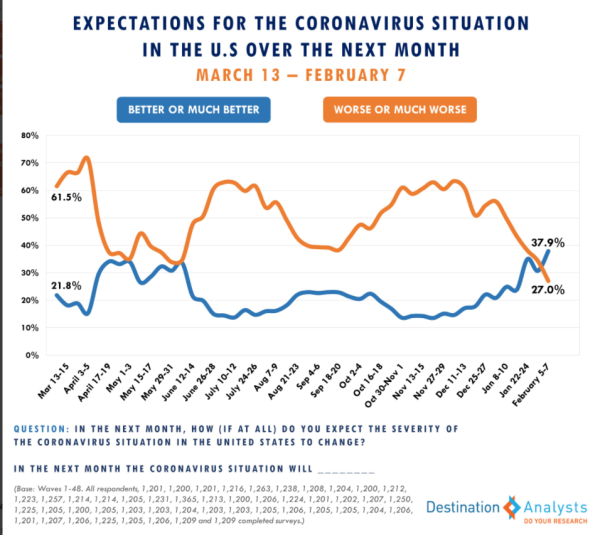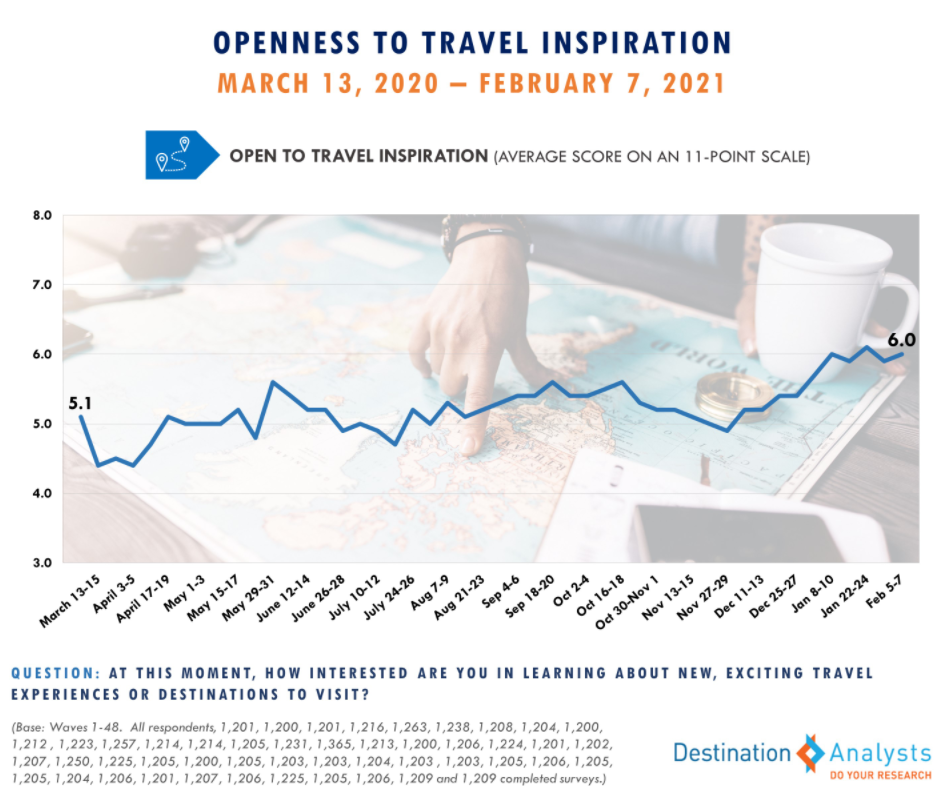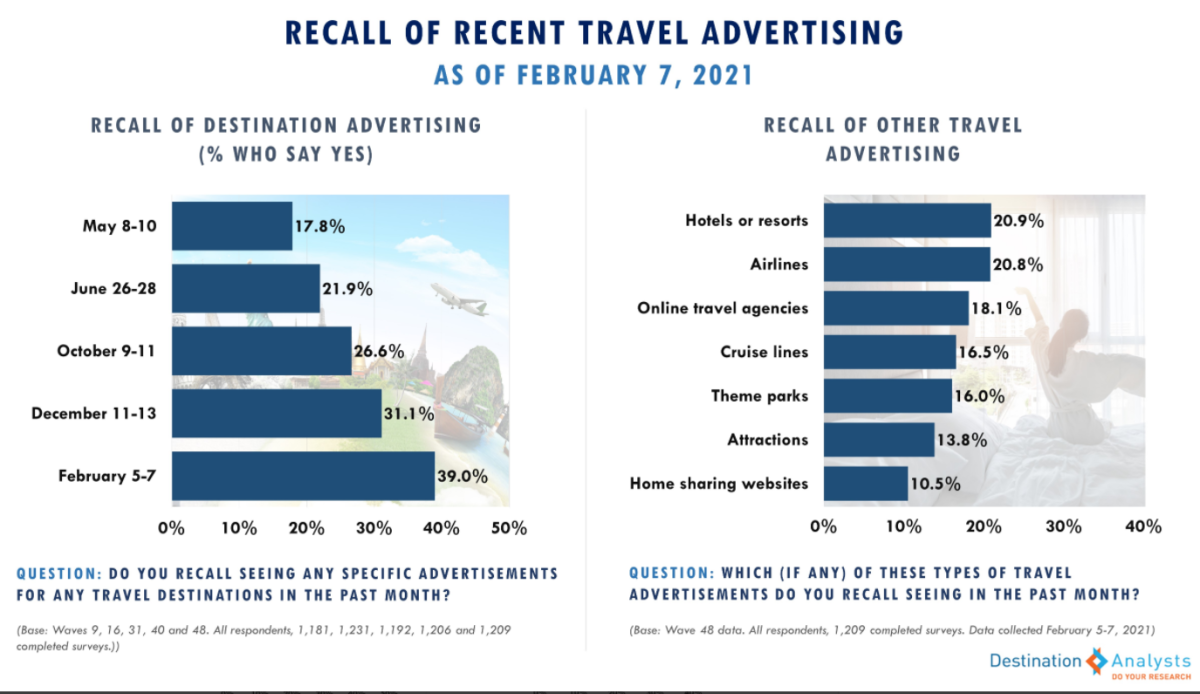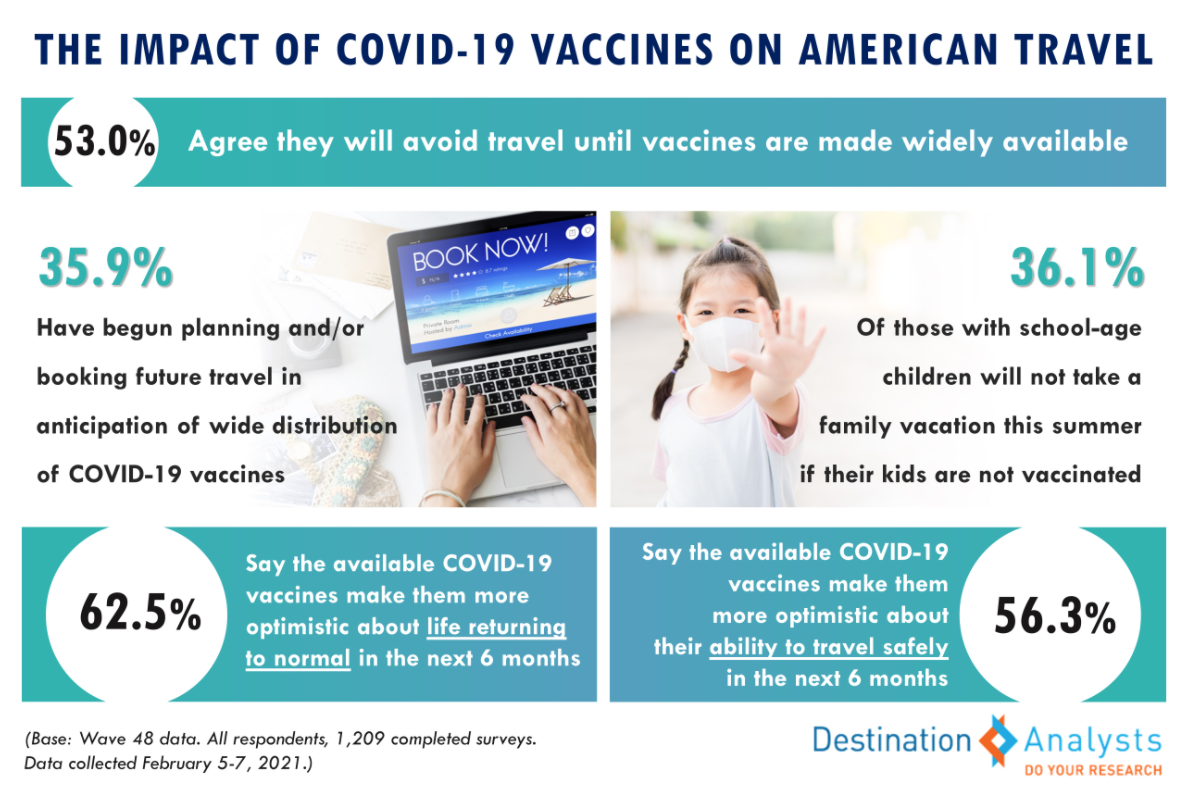IMPORTANT: These findings are brought to you from our independent research, which is not sponsored, conducted or influenced by any advertising or marketing agency. Every week since March 15th, Destination Analysts has surveyed 1,200+ American travelers about their thoughts, feelings, perceptions and behaviors surrounding travel in the wake of the coronavirus pandemic, and explored a variety of topics. The findings presented below represent data collected February 5th-7th.
For the first time, optimism about the course the pandemic will take in the United States over the next month significantly outweighs pessimism. Nevertheless, Americans are frequently experiencing burn out and cabin fever and thus may need travel more than ever.
IMPORTANT: These findings are brought to you from our independent research, which is not sponsored, conducted or influenced by any advertising or marketing agency. Every week since March 15th, Destination Analysts has surveyed 1,200+ American travelers about their thoughts, feelings, perceptions and behaviors surrounding travel in the wake of the coronavirus pandemic, and explored a variety of topics. The findings presented below represent data collected February 5th-7th.
Key Findings to Know:
- Although financial worries remain elevated, Americans’ anxiety about contracting the coronavirus is down.
- For the first time ever, optimism about the course the pandemic will take in the United States over the next month significantly outweighs pessimism.
- Staying safe from infection remains a top priority for Americans as they consider their lifestyle over the next 6 months, although close behind are finding joy and happiness, emotional well-being and relaxation. Compared to the early period of the pandemic last Spring, more Americans say they will prioritize having new experiences, as well.
- These lifestyle priorities may be in response to negative aspects weighing on mental wellness during this ongoing pandemic. American travelers rate their daily stress levels at 5.6 on a 10-point scale on average. Nearly half of Americans report feeling symptoms of burn out at least half the time in the last month, and an even greater number—53.1%–say they have as frequently felt cabin fever.
- American travelers’ primary motivations for taking their next trip are far and away to relax and escape stress and spend time with family.
- Americans remain in a state of openness to travel inspiration that is greater than any other period in the last 11 months (6.0/10).
- In total, 39.0% of American travelers say they saw one or more ads for travel destinations in the past month, up from 31.1% in December and 17.8% last May. In terms of other types of travel advertising, one-in-five American travelers recall seeing a hotel or resort ad in the last month, and a similar proportion recall seeing an airline ad. Americans continue to be increasingly comfortable with advertisements of their own communities for tourism.
- The imperative role of COVID-19 vaccines in travel industry recovery continues to be reiterated. Emphasizing the relationship between vaccination rollout and travel volume, over half (53.0%) of American travelers agree they will avoid travel until vaccines are made available. In addition, over a third (36.1%) of parents with school-age children say they will skip the family vacation this summer if their kids are not vaccinated. Nevertheless, the availability of the vaccines continues to be a source of hope and optimism, as well as inspiration to plan and book travel.
- As of this week, 81.2% of American travelers report they have at least tentative trip plans right now, and 60% have taken some action in the planning tasks for their next trip.
- About half of Americans anticipate taking at least one leisure trip within the next 3 months. In looking at the accommodations they expect to stay in on these upcoming trips, hotels are most common.
How are we feeling now? As it so happens, this was a good week to ask. Although financial worries remain elevated, Americans’ anxiety about contracting the coronavirus is down. For the first time ever, optimism about the course the pandemic will take in the United States over the next month significantly outweighs pessimism. This week, 37.9% of American travelers feel the situation will get better in the next month, while just 27.0% believe it will get worse—a record low.

Staying safe from infection remains a top priority for Americans as they consider their lifestyle over the next 6 months, although close behind are finding joy and happiness, emotional well-being and relaxation. Compared to the early period of the pandemic last Spring, more Americans say they will prioritize having new experiences, as well. These lifestyle priorities may be in response to negative aspects weighing on mental wellness during this ongoing pandemic. American travelers rate their daily stress levels at 5.6 on a 10-point scale on average, meaning more than moderate, occasional stress. Younger Americans continue to feel far more daily stress than older Americans. Nearly half of Americans (48.4%) report feeling symptoms of burn out at least half the time in the last month, and an even greater number—53.1%—say they have as frequently felt cabin fever.

Although the state of Americans’ mental health may be less than ideal, travel can serve as salve. American travelers’ primary motivations for taking their next trip are far and away to relax and escape stress (45.7%), and spend time with family (43.2%). Americans continue to perceive the safety of travel and leisure activities as safer than at any other period of the pandemic, and travel guilt is slowly declining (48.6%). Nearly three-in-ten (28.2%) have observed more travel among their personal networks lately. In terms of their state-of-mind around travel, 56.8% are feeling readiness versus hesitation. The average level of excitement about travel in 2021 is even slightly greater than at the start of the year (5.9 vs 5.8). Very importantly, Americans remain in a state of openness to travel inspiration that is greater than any other period in the last 11 months (6.0/10).

Advertising may play a role in this excitement and openness Americans are feeling. In total, 39.0% of American travelers say they saw one or more ads for travel destinations in the past month, up from 31.1% in December and 17.8% last May. This rate is similar across the entire U.S., although younger travelers are likelier to recall such destination advertising. In terms of other types of travel advertising, one-in-five American travelers recall seeing a hotel or resort ad in the last month, and a similar proportion recall seeing an airline ad. Americans continue to be increasingly comfortable with advertisements of their own communities for tourism. This week 40.9% said they would be happy if they saw an ad promoting their home city or town as a place for people to visit when safe.

The imperative role of COVID-19 vaccines in travel industry recovery continues to be reiterated. Emphasizing the relationship between vaccination rollout and travel volume, over half (53.0%) of American travelers agree they will avoid travel until vaccines are made available. In addition, over a third (36.1%) of parents with school-age children say they will skip the family vacation this summer if their kids are not vaccinated. Nevertheless, the availability of the vaccines continues to be a source of hope—62.5% say they make them more optimistic about life resuming to normalcy in the next 6 months and 56.3% say they make them more optimistic that they can travel safely in the same period. In addition, over a third of American travelers report they have begun planning and/or booking future travel specifically in anticipation of a wide distribution of COVID-19 vaccines.

As of this week, 81.2% of American travelers report they have at least tentative trip plans right now, and 60.0% have taken some action in the planning tasks for their next trip, including researching destinations to visit (26.4%), researching their lodging options (17.1%) and researching travel activities (14.7%). About half of Americans anticipate taking at least one leisure trip within the next 3 months. In looking at the accommodations they expect to stay in on these upcoming trips, hotels are most common. Nearly one third plan to stay in a full-service 3 or 4-star hotel, while just under a quarter plan to stay in a 5-star luxury hotel.

-end-






